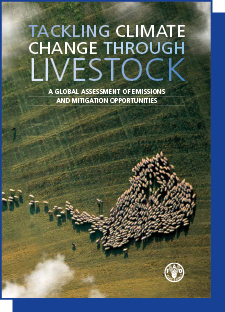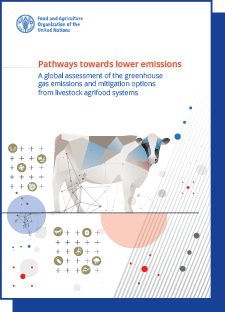How Improved Livestock Health Can Reduce GHG Emissions
Livestock are a critical resource for the over 1.7 billion people worldwide who rely on them for their livelihood. These animals provide important food and nutrition to our food supply, while helping drive economies. However, with livestock production representing approximately 12% of global GHG emissions,1https://www.fao.org/newsroom/detail/new-fao-report-maps-pathways-towards-lower-livestock-emissions/en it is important to consider how our world can maintain these benefits while protecting our climate. Recent analyses from peer-reviewed studies to United Nations institutions have found that better livestock health can be a powerful climate solution for animal agriculture.
Disease increases GHG emissions of livestock production
Animals that are sick consume more feed and water, while growing at a slower rate. When an animal is lost to disease, it means resources must be re-invested in raising another animal to meet market demand. This means disease leads to higher GHG levels per unit of milk, meat and eggs because more animals and resources are ultimately needed to maintain productivity.
Effects of Disease on Beef Cattle Emissions2https://academic.oup.com/af/article/9/1/69/5173494
Bovine Viral Diarrhea – Up to 130% increase
Johne’s Disease – Up to 40% increase
Salmonella – Up to 20% increase
Effects of Disease on Dairy Cattle Emissions3https://academic.oup.com/af/article/9/1/69/5173494
Johne’s disease – Up to 25% increase
Salmonella – Up to 20% increase
Bovine Viral Diarrhea – Up to 20% increase
Every 1% increase in parasitic worms in sheep results in a 0.52% increase in emissions4https://www.ncbi.nlm.nih.gov/pmc/articles/PMC7539894/
Effects of Diseases are More Pronounced in Developing Markets
Animal disease significantly reduces the global productivity of livestock farming each year, particularly in developing regions where access to veterinary care and vaccinations may be minimal.
An outbreak of cattle disease affecting 20% of a herd is associated with:5https://healthforanimals.publishingbureau.co.uk/reports/animal-health-and-sustainability/
60%
increase in emissions in low income countries
42%
increase in high-income countries
“The main reasons for the high level of emission intensities [in South Asia] are…poor quality feed and high mortality rates.”
United Nations Food and Agriculture Organization6https://www.fao.org/3/i3437e/i3437e.pdf

United Nations Recommends Animal Health as a Climate Solution
Recent reports from the United Nations Food and Agriculture Organisation (FAO) have evaluated how livestock production can help bridge global nutrition gaps, while simultaneously reducing emissions. The two most impactful solutions were increasing productivity and better animal health.

Increased productivity and improved animal health can reduce global livestock emissions by 30%, according to a recent UN report.7FAO, Pathways to lower emissions, Table 3, https://www.fao.org/3/cc9029en/cc9029en.pdf
Healthy livestock produce fewer emissions
There is a direct link between GHG emissions and animal health. Healthy animals are more productive and sustainable as they require fewer natural resources to thrive, leading to a lower environmental impact.
Source8https://ec.europa.eu/eurostat/statistics-explained/index.php?title=Greenhouse_gas_emission_
Studies across the globe have measured the effects of various animal health interventions on the GHG emissions of livestock production, finding that these technologies can be a climate solution for animal agriculture.
Vaccination
East coast fever vaccination in cattle reduces emissions up to 40% in East African countries9https://www.fao.org/3/cc0431en/cc0431en.pdf
Parasite Control
Parasites can increase methane emissions by 33%, which is why studies have found deworming can drastically cut emissions10https://www.sciencedirect.com/science/article/abs/pii/S0020751918301723
Biosecurity
Control of Highly Pathogenic Avian Influenza (HPA) reduces emissions by 11.3%11https://onehealthoutlook.biomedcentral.com/articles/10.1186/s42522-023-00089-y
Genetics
Better genetics could reduce livestock emissions by 8% across the EU and up to 24% of methane emissions in the Netherlands12Impact of animal breeding on GHG emissions and farm economics, European Commission,13https://www.sciencedirect.com/science/article/pii/S1751731121001373
Healthy animals for a healthier world
The data is clear. Better animal health means higher productivity, lower emissions and fewer people going hungry. Healthy animals are a cornerstone of sustainable food systems
Spotlight: Feeding 9+ Billion
A recent report analysed UN data and found that scaling up existing practices in animal health and husbandry means livestock could serve a world population of more than 9 billion in 2050. Here’s how:
UNFAO estimates that an increased uptake of existing animal health and husbandry technologies and practices can reduce livestock emissions intensity by 18–30% .
This intensity reduction could allow livestock farmers to increase production by an estimated 46.7 billion kg a year, enough to meet the needs of another 1.6 billion people, while holding overall emissions at current levels.
With the global population at 8 billion, this means that increased adoption of existing tools in animal health and husbandry could enable livestock to serve more than 9 billion people in 2050 without increasing emissions.
- 1
- 2
- 3
- 4
- 5
- 6
- 7FAO, Pathways to lower emissions, Table 3, https://www.fao.org/3/cc9029en/cc9029en.pdf
- 8
- 9
- 10
- 11
- 12Impact of animal breeding on GHG emissions and farm economics, European Commission
- 13
